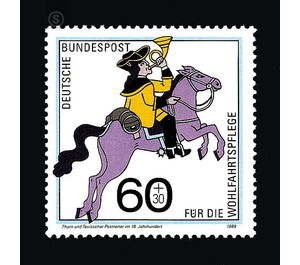welfare: mail delivery over the centuries - Germany / Federal Republic of Germany 1989 - 60 Pfennig
Theme: Animals
| Country | Germany / Federal Republic of Germany |
| Issue Date | 1989 |
| Face Value | 60.00 |
| Color | multi-colored white |
| Perforation | K 13 3/4 |
| Printing Type | Multicolor offset printing |
| Stamp Type | Postage stamp |
| Item Type | Stamp |
| Chronological Issue Number | 1310 |
| Chronological Chapter | GER-BRD |
| SID | 982268 |
| In 36 Wishlists | |
The Deutsche Bundespost is this year the 40th welfare stamp series in favor of the free welfare care out. The recipient of the proceeds from the sale of these special stamps is the "Federal Working Group of the Free Welfare Association", which includes the Arbeiterwohlfahrt, the Diakonische Werk of the EKD, the German Caritas Association, the German Paritätische Wohlfahrtsverband, the German Red Cross and the Central Welfare Office of the Jews in Germany have joined together. These organizations help wherever government aid is not enough. The welfare stamps of 1989 show the »mail delivery over the centuries«. In 1490, the king (and later Emperor) Maximilian I. by the family taxis (it was called only from 1650 Thurn and taxis) set up a mail line from Innsbruck through Germany to Mechelen (north of Brussels) to the traffic between his farms to improve. There were fixed stations, each with fresh riders and horses ready to carry the letters in the relay system day and night immediately. As a result, messages were transmitted about twice as fast as the usual messengers who made their way to their destination alone. They lost a lot of time through breaks, overnight stays and the fatigue of the horses. The beginning of a fast mailing with fixed stations in the year 1490 takes the occasion of the German Federal Post Office, in the year 1990 the anniversary "500 years post" to commit. From 1490 letters and small parcels were transported by riding posts at first and for a long time. The consignments were kept in the so-called Felleisen, a roll-shaped leather bag that was lashed to the saddle. The increase in the exchange of goods led around 1650 to the introduction of mail wagons on which not only bales of material, bulky parcels and sometimes even "stinking herring tons" could be carried more than a fair amount of persons, at first without any protection against the weather and with a "speed "From about 6 to 8 km an hour - if the roads were not too muddy. Conditions did not improve until 1800, when more roads were built. Still, however, was the fast Briefbefördenung the riding post. In 1821, the Prussian Post Office introduced the first express post. With lighter and better spring-loaded mail wagons, people were increasingly carrying mailbags and valuables. This made many riding posts unnecessary. Other German postal administrations (around 1850 there were still 15 different) followed this example. Until the 19th century, Swiss Post provided only the long-distance transport of consignments. Upon arrival at the place of destination, the letters were registered in »a card«, which was posted at the post office. Only when the letters were not picked up after a certain time, they were delivered - for an additional fee. In large cities (eg in Paris, Vienna, Berlin or Hamburg) there was a "small post" dealing with the collection and delivery of local broadcasts. (Text: Federal Postal Museum Frankfurt am Main)


